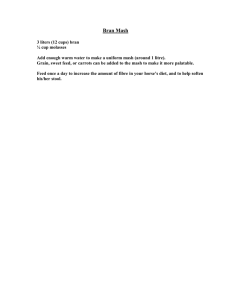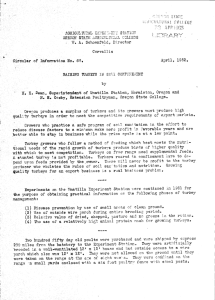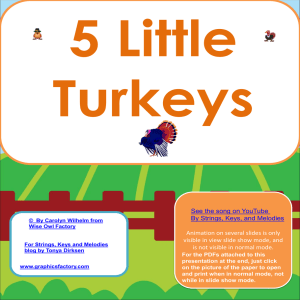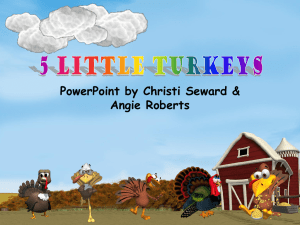Extension Circular 314 April, 1938 H. E. Cosby, Head, Poultry Department
advertisement
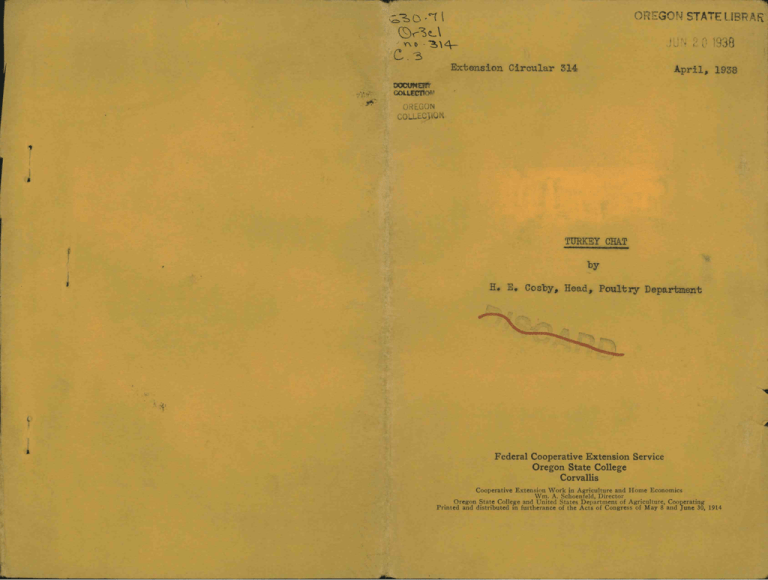
OREGON STATE t.IBA D Extension Circular 314 April, 1938 DOCU?E GOLLECThY" U E.G UN COLLE.CJQ I. I i TURKEY CHAT by H. E. Cosby, Head, Poultry Department a Federal Cooperative Extension Service Oregon State College Corvallis Cooperative Extension Work in Agriculture and Home Economics Wm. A. Schoenfeld, Director Oregon State College and United States Department of Agriculture, Cooperating Printed and distributed in furtherance of the Acts of Congress of May 8 and June 30, 1914 Extension Circular 314 April, 1938 TURKEY CIAT . by H. E. Cosby, Head, Poultry Department Profits derived from raising market turkeys vary from year to year in accordance with changing economic conditions and the soundness of the farm program followed in rearing them. In 1935 the ratio of low fOod costs to favorable turkey prices reèulted in a greater profit per bird than could be expected to continue over a period of years. In 1936 beginners wore attracted to the business; established growers expanded their operations; liberal credit became a commercial policy; the industry was over-expanded; feed prices increased and the results were chaotic marketing and unsatisfactory prices. In 1937 feed prices were higher; credit was more difficult; the crop was smaller and the price paid per pound of turkey meat left a margin of profit for the efficient growers. In 1938 the early predictions indicate a slight increase in numbers to be reared, a longer hatching season, reduced feed costs, lower priced competitive meats and an unoerbain consumer's purchasing power, COMPETITION AND MARKETS Oregon raises approximately one million turkeys annually. Each state in the Union also raises turkeys. Oregon must find markets outside of the state for approximately two of each three turkeys raised. Oregon turkeys are known far and wide for their fine quality. The adoption of arbifiolal methods of rearing turkeys has resulted in. an increased nuiiber being produced in states near the large terminal markets to which Oregon turkeys must be shipped. Such industry problems as quality improvement, lower production costs, orderly marketing, improved packaging for the consumers and adverbising must be given serious consideration by all concerned if the industry is to profitably meet competition from other producing areas and from other food commodities, The Oregon turkey grower is fortified by years of experience and availability of quality breeding stock. He is further protected by having a choice of two methods of marketing his turkey oropt through established independent dealers and established cooperative marketing associations serving the western surplus producing areas, He is still further fortified by having a choice of purchasing his feeds either through cooperative or independent feed agencies. a I A GOOD FEED IS A NECESSARY INVESTT The turkey must be supplied with the feed nutrients necessary for its normal growth. Feed is only one .otor in uocessft1 turkey farming but it is the greatest item of costs involved. There are on the market many excellent commercial turkey feeds which are being used successfully by growers. A large nuniber of request from prodoers, dealers and milla is reoeived for information on turkey feed formulas and methods of feeding. It is hoped that this brief material will present a broader answer to the many questions asked than can be given in regular correspondence. MA.SH FORMULA, REFERENCES AND SUGGESTIONS BREEDER 240 lbs. bran ---------------" 300 500 250 100 100 100 80 80 180 20 30 20 ground yellow corn-- " ground wheat -------- " ground whole oats--ground barley------. " meat scraps- ------- fish meal ---------- - " powdered " dried whey-- ------- alfalfa ------------- " " " oyster shell flour-steamed bone meal--fine salt- -------- - 2000 lbs, (Add 10 to 12 lbs. vitamin bearing fish oil of 400-D and 3000-A potency, or its equivalent STARTER DEVELOPER 300 lbs. --------------- 300 lbs. 400 450 It 100 0 200 180 100 It 300 400 'I II It It It -- 200 200 100 200 60 40 140 " " ' ' ' " 40 160 lt 10 It 10 " 40 20 II 30 ' It 20 II 2000 lbs. (Same general vitamin D recommendations as for breederts mash.) or 30-40 lbs. of oil of U.S. potency.) ' ' 2000 lbs. (Use about one-third the amount of oil previously referred to for birds on free range after 10-12 weeks.) SCRATCH GRAIN REFERENCES BREEDER 1000 lbs. wheat 400 400 200 " " " 2000 lbs. corn oats rolled barley STARTER DEVELOPER 1000 lbs. or, wheat 1000 ' or. corn 1000 lbs. wheat 500 " or. corn 300 " barley 200 " oats 2000 lbs. 2000 lbs. L S 4 3 FEED QOMMENTS The turkey cannot reproduce or grow normally unless it receives iii reasonable balance the six different classes of nutrients grouped as follows: water, proteins, fats, carbohydrates, minerals and vitamins. There is no one best feed formula. Any feed, however, which meets the requirements of the bird for whatever purpose it is fed must be built to supply the required units of each vitamin, the calcium phosphorus ratio of the feed intake and other class nutrient requirements. Mash and scratch feed forimilas are elastic and the listed ingredients may be increased, decreased, eliminated or be replaced with others when price warrants, where palatability ia not seriously affected and the ration consumed is not thrown out of balance. Farms which provide liquid milk in ample amounts may eliminate powdered milk ingredients. Farms that supply an abundance of succulent green feed throughout the breeding, brooding, growing and early part of the finishing periods can reduce by two.thir or more the dried alfalfa mash ingredients. A uniform, coarsely ground mash is more palatable than the same in.. gredients ground to a powders, fineness. Feed in pellet form is preferred by many growers and has an economic advantage in strong wind areas. A reasonably coarse mash is less likely to promote feather pulling and similar oaflnibaliatic vices. However, tieae vices do develop in some flocks on every type of feed used. Less crowding, more feed hoppers, more green feed, segz'e gation of sexes and other management practices will do much in reducing such vices to the minimum. The mash formulas given here are quite similar with respeot to 1mM gredients and vary only in amounts used for the different purposes of the particular feed. Numerous combinations, additions, reductions, eliminations and substitutions might be wisely made without destroying the balance of the nutrients. The turkey business becoming a business in which only a. small margin of profit per pound i left grower. A greater utilization of home grown feed and grains should be practiced. is rapidly for the efficient BREEDING STOCK 1, Breeding stock prospects should be marked throughout the growing season and selected in the early fall and separated from the market flock. They should not go through two or three fattening periods with the market band and then be out back and called breeders, 2. A large flock mating should have access to a range which provides hiding places for more seclusive matings without interference from other toma. Feed troughs should be distributed over a wide area, not only to scatter the birds and afford mating opportunities but primarily to prevent a concentration of contamination. 3. Harem mating (one torn to 10.45 hens) should not be made in. adjoin-. ing yards, unless partition fences obstruct vision from one yard to another. Tons spend too much time fighting through the fencesj breeders show favoritism for individuals in adjoining pens and fertility is sacrificed. 4. Turkey breeding stock should be wintered on a bulky grain ration, green feed or hay, and plenty of exercise in. order to avoid excessive fat. During January they should have part-time access to a well-.balanoed breeder's mash, As the season advances, free access to mash, greens, grain, hard grit and oyster shell is given. It is oomuon practice of many to also provide hoppers of granulated bone and charcoal. The hen manufactures the egg if supplied the right materials. If range doesn't supply them (it rare]y does), the owner must do so. 5. Various systems are followed in alternating the breeding toms. Extra tons should be held over for emergency replacement regardless of the methods of mating employed. 6, Turkey breeders are usually dressed out or sold live weight as soon as the breeding season is over, Hot weather at this time of year may result in loss of oarcass value unless immediate pre-000ling facilities are available1 7. Turkey breeders are usually fed a ration rather high in. cod liver fish oil content, This ingredient, as with fall and winter marketed turkeys, should be discontinued a few weeks prior to sale for food purposes as some oils fed in liberal amount affect the flavor of the meat, or 8. Turkeys should also not be marketed for 15 days after they have roosted on perches treated with Black Leaf 40 for body lice eradication. The nicotin.e fumes affect the flavor of the meat. HATCHING EGGS 1, Turkey eggs saved range of 40 to 65 degrees. for hatching should be held within a temperature 2. .&r egg case equipped with turkey or duck egg fillers provides a safe storage place and tilting the case makes turning much quicker and easier. 3. A turkey egg that weighs less than 2 3/4 ounces is not often a desirable hatching egg. One that weighs much in excess of 3 1/2 ounces is all too often double yolked and an economic waste of incubator space. 4. Eggs saved for hatching should not, for optimum results, be held longer than 14 days. 5. Eggs being held for hatching should be turned once or twice daily after the first week. 6, Any egg can hatch only that which has been fed and bred into it, FEEDING SCHEDULE DURING BROODING AND GROWING PERIOD AGE First SCRATCH MASH DRINK None Norie None 36 to OTHER Hold in shipping boxes or in incubator, Poul will come out and learn to eat faster if roan 48 hours temperature for a day or two is 700 or warm- er, First None first few to Sprinkle light grain feed on feed end of week days. dry mash ocea- sionally after 5th day. - ------- -- Objects 1st week: 1. Teach poulta source of heat, 2, Teaoh poults to eat, - 5 or 6 feeds Warm daily. Necessary water to devote time to teach them all to Cover litter with sacks or screen platform Hard boiled eggs (30 miii.) added Use hinged 12" boards eat, See that each poult get food arid drink, until poults learn to eat. or wire frames to keep poulta near brooder. Enlarge this area daily. to dry mash. makes it cruiithly moist. Dry cottage cheese sprinkled over dry mash aids in teaching Reduce heat gradully poults to eat, after first week. Gradually e].imin- ate eggs or cheese as soon as all poults learn to eat, Second week to firiish- hg thins Gradually work Leaw dry mash toward leaving before poults. hoppers before Change to developing mash grain in them at all times, by time poults go on clean range, where some shade is provided for. Water Avoid damp- ness around all water foun- tame. Set water vessels on Wi re covered frames. - 4__ Get poults outside, Supply succulent greens. Feed hard grit. Provide temporary roosts by 34 weeks. Provide additional feed hoppers. Move range roosting quarters frequently. Plan and plant a contunuous green feed supply through sunmier and fall, Range sexes separately if possible. Dou't run turkeys with ohiokens or on soil used by chickens. -! a FINISHING TURKEYS FOR MARKET Weather is an important factor which affects the time when turkeys "arrive" at prime flesh and feather maturity regardless of the method of Breeding for both maturity and feather growth may be factors finishing used. far greater than those now accredited to weather conditions. The problem of finishing turkeys is often complicated by the fact that young turkeys of several ages are running together in the same flock. A strict fattening feed which would finish for market the oldest ones might deprive the younger birds, forced to eat the same feed, of necessary food elements needed for growth and resistance. Unless separation of older birds to be fhttened from younger ones still growing is practicable, the practice of feeding both grain and developing mash (minus excessive fish meals and fish oils) is best. If older turkeys can get what they need, they won't make any mistake in taking on a fine finish. If younger turkeys can't get what they need, then troube will be incurred. The method uaed in finishing turkeys very often differs from farm to farm because the flock conditions are vastly differenb, Turkeys fed throughout their growing lives are in good flesh at all times. The last few weeks prior to slaughter is devoted to feeding practices designed to get the birds in prime flesh. It is a dangerous practice from the viowpoinb of oompetivo marketing with other districts for growers to slaughter any birds that are not im prime flesh. Price "jitters" has prompted too many growers to market many of their turkeys before they were finished. An export market an easily be lost to someone else by such an uneconomic practice. }THODS OF FINISHING A low protein fattening mash, or pellet, which is fed in connection 1. with liberal grain consumption. A low protein fattening mash, or pellet, is fed as an allinclusive 2. finishing feed. A relatively high protein developing mash fed with grain whereby 3. turkeys of different ages in the same flock have free choice to either. Exclusive feeding of grains during the last few weeks prior to Turkeys of this age are still growing and can utilize to ad.. slaughter. 'vantage additional proteins, minerals, eta. which the exclusive grain diet does not provide. Exclusive grain feeding over too long a period of time costs more per pound of gain than. where some mash, or pellets, is fed, Many prefer grain as an exclusive diet during the last two weeks only. 4. Grain aided by free access to liquid milk is a method of finishing 5. turkeys which is successfully praoticed. by many farmers. Hogging down sunflowers and fields of corn with turkeys having access to mash is a practice which has given good results at a lesser oash 6. outlay. - .4 7 FINISHING MASH REFERENCES A mash consisting of the following ingredients has satisfactorily met firi.ishthg and growth requirements during the six or eight weeks finishing period and where the birds also had access to grain. 200 lbs. bran or milirun 500 ground yellow corn 600 " ground wheat 200 IL ground oats 200 " ground barley 100 meat scraps 60 " powdered milk 80 alfalfa 20 " shell flour 20 bone meal 20 " salt 2000 lbs. CAUTION The industry as a whole has suffered from reports and actual cases of fishy flavored turkeys purchased by consumers. Most of Oregon's turkey crop is dependent upon public favor in out-of.state markets, The number of birds affected was email from this and other states but it does not take many such birda to injure the industry. Opinion ran rife and exaggerations were immerous, partioularly during the 1936 marketing season. The poultry department of Oregon State College in cooperation with members of the Oregon Poultry Council conducted three separate feeding, killing, storage and cooking tests involving 100 turkeys during 1936-37 to secure basic information which could be used to oorreot the situation and protect the investments of the producers. The splendid cooperation of buyers, cooperatives, feed martufaoturers, producers, educational agencies all working together eliminated almost 100% the fishy flavored turkey objections during the 1937-38 marketing season. Complete reports have been issued regarding each of the experiments conducted and only brief mention will be made here of the salient points to be observed in finishing turkeys, Off-flavored turkeys were produced: 1. With 20% high grade fish meal in a mash to which was added 2% of a fish oil (not U.S.?.) and the turkeys given free ohoioe of mash and grain. 2. With an all-mash finishing ration containing 10% high grade fish meal to which was added of a U.S.?. vitamin D oil, With 10% high grade fish meal in an all mash ration to which 3. was added 1% of an U. S. P. vitamin D oil. 4.. With a mash containing neither fish meal nor fish oils but where turkeys had free access to grain which had 2% U. S.. P. oil mixed with it . With an all mash ration containing 10% foreign fish meal to which was added 1% of off odor, off color, not U. S. P. vitamin D oil,. 5., 6, With an all mash ration containing 10% foreign fish meal to which was added 2% of off odor, off color, not U.S.P. vitamin D oil, IECOENDATIONS JIRD SUGGESTIONS Some flock owners have fed excessive amounts of vitamin D oils during the finishing period to hasten the finish, to promote feather maturity and to cure colds or roup, The abuse of vitamin D oils rather than the legitimate use of them can in no small measure be responsible for a condition which can easily undermine the industry. The liberal feeding of fish oils in connection with liberal fish meal content of the mash is known to produce objectionable flavors. The problem is more complicated by the various grades and qualities of each which might be Used, Turkeys live, grow and fatten outdoors. There isn't the need of heavy fish and fish oil feeding during the few weeks prior to slaughter. It is recommended that combinations of fish meals and fish oils be generally eliminated during the few weeks final fattening period..
